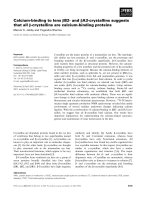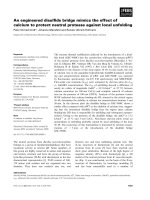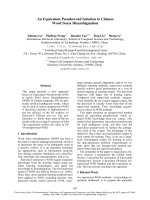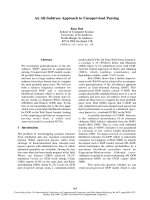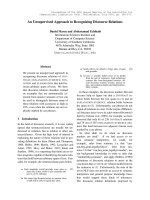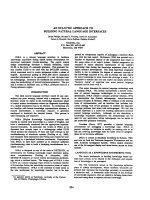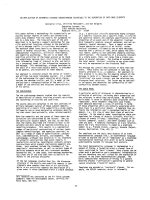báo cáo khoa học: " An appeal to humanity: legal victory in favour of North America’s only supervised injection facility: Insite" pptx
Bạn đang xem bản rút gọn của tài liệu. Xem và tải ngay bản đầy đủ của tài liệu tại đây (349.73 KB, 3 trang )
BRIE F REP O R T Open Access
An appeal to humanity: legal victory in favour of
North America’s only supervised injection facility:
Insite
Dan Small
1,2
Abstract
Canada’s federal government has once again failed to shut North America’s only authorized supervised injection
facility: Insite. A majority ruling issued by the BC Court of Appeal on 15 January 2010 upheld an earlier British
Columbia Supreme Court ruling in 2008 that protected the rights of injection drug users (IDUs) to access In site as
a health facility as per the Charter of Rights and Freedoms component of the Constitution of Canada. The majority
decision from Honourable Madam Justices Rowles, Huddart and Smith also established a jurisdictional victory safe-
guarding Insite as most appropriately run under the authority of the province of British Columbia rather than the
federal Government of Canada. The Federal Government has appealed the case to the Supreme Court of Canada.
A hearing date has been set for 12 May 2011. The appeal will be a legal one but even more so, it will be an
appeal to humanity.
Canada’ s federal government has once again failed to
shut North America’s only authorized supervised injec-
tion facility: Insite. A majority rulin g issued by the BC
Court of Appeal on 15 January 2010 upheld an earlier
British Columbia Supreme Court ruling in 2008 that
protected the rights of inject ion drug users (IDUs) to
access Insite as a health facility as per the Charter of
Rights and Freedoms compo nent of the Constitution of
Canada.
The majority decision from Honourable Madam Jus-
tices Rowles, Huddart and Smith also established a n
important jurisdictional victory emerging from the cross
appeal by the operat ors of Insite: the PHS Community
Services Society (PHS). The ruling further safeguards
Insite as most appropriately run under the authority of
province of British Columbia rather than the federal
Government of Canada.
Insite opened on 21 September of 2003 under an
exemption granting it status as a scientific pilot study
until 12 September 2006. The primary goals of the pro-
gram are: (1) to reach a marginalized group of IDUs with
healthcare and supports who would otherwise be forced
to use drugs in less safe settings (2) to reduce dangerous
injection practices (syringe sharing) thereb y reducing the
risk of infectious diseases like HIV and HCV; and (3) to
reduce fatal overdoses in the population of people that
use the facility. The p rogram also aims to provide refer-
rals to treatment and detoxification, reduce public diso r-
der (public injection) and validate the personhood of a
deeply stigmatized target population [1].
The legal battle began near the end of Insite’s three-
year exemption for sc ientific study when a minority
conservative government was elected in Canada on 6
February 2 006. The new government voiced opposition
to the program during and after the election [2-4]. On 1
September 2006, the program was given a temporary
extension to operate until 31 December of 2007. Before
this reprieve, the community waited in apprehension.
The photograph below (Figure 1) shows an announce-
ment of support for the supervised inj ection facility
from a humble church in the inner city of Vancouver
where Insite ma kes its home. This same church opens
its pews up each night for the homeless to sleep and
has held many services for local residents who died of
preventable overdoses before Insite was opened. [insert
figure here] Fo r the peo ple living with addictions and
their families who face the dangers of preventable over-
doses and infections in their everyday lives, the fate of
Correspondence:
1
Director PHS Community Services Society Vancouver, Canada
Full list of author information is available at the end of the article
Small Harm Reduction Journal 2010, 7:23
/>© 2010 Small; licensee BioMed Central Ltd. This is an Open Access article distributed under the terms of the Creative Commons
Attribution License ( whi ch permits unrestricted use, distribution, and repro duction in
any medium, provided the original work is properly cited.
the injection facility is neither academic nor legal. It is
risk that is lived [5].
On 2 October 2007, the project was given an additional
exemption to operate under the Controlled Drugs and
Substances Act until30June302008.Aloomingthreat
of closure by the conservative led government led the
PHS to take the Government of Canada to court in late
2007 [6]. The outcome of this first legal case determined
that the Controlled Drugs and Substances Act (CDSA) in
Canada is unconstitutional as it pertains to Insite because
the closure of the program under the Act would impede
people with addictions from receiving life saving health-
care. BC Supreme Court Justice Ian Pitfield ruled that the
use of the CDSA to shut Insite would undermine the
fundamental right, under Canada’s Charter of Rights and
Freedoms to life, liberty and security of the person [7].
Since its incepti on, Insite has been subject to an inde-
pendent review by a t eam of physicians and scientists
put in place to provide an “arm’slength” evaluation of
the program. The results of t his scientific evaluation
have been published in peer-reviewed academic journa ls
and have indicated that Insite has reduced unsafe injec-
tion practices, public disorder, overdose deaths and
HIV/Hepatitis while increasing uptake of addiction ser-
vices and detox [8]. To date, there have been over
three-dozen peer-reviewed papers evaluating Insite pub-
lished making it one of the most evaluated healthcare
programs in the history of Canada [9-38]. In light of the
evidence, the program has garnered widespread support
from Canadian physicians, scientists and healthcare pro-
fessionals [39].
Despite this support from the s cientific and medical
community, the Conservative government of Canada
remains entrenched in its position having served th e
PHS w ith court documents indicating their intention to
appeal the case of Insite to the highest court in the
country: the Supreme Court of Cana da [40]. A court
date to hear the case has been set for 12 May 2011 by
the Supreme Court of Canada. It appears that science
and ideology are once again at odds while Canada’ s
highest court is asked to determine whether the earth is
flat or round in the universe of addiction. When Insite
reaches the end of its legal journey in Canada, hopefully
the courts will once again rule that addiction is princi-
pally an issue for the Chief of Medicine rather than the
ChiefofPolice.Asaresult,thecaseismorethanan
appeal to the Canada’s highest court; it is an appeal to
the country’s humanity.
Author details
1
Director PHS Community Services Society Vancouver, Canada.
2
Department
of Anthropology University of British Columbia Vancouver, Canada.
Competing interests
The author declares that they have no competing interests.
Received: 6 July 2010 Accepted: 9 October 2010
Published: 9 October 2010
References
1. Small D: Looking in the cultural mirror: addiction, secret lives and lost
personhood. Visions Journal 2005, 2:29-30.
2. Small D: Fools rush in where angels fear to tread: Playing God with
Vancouver’s supervised injection facility. International Journal of Drug
Policy 2007, 18:18-26.
Figure 1 Photograph of church marquee advertising an upcoming sermon in Vancouver’s downtown eastside. Photograph by D. Small
Small Harm Reduction Journal 2010, 7:23
/>Page 2 of 3
3. Canada: Standing Committee on Health: Transcript of Meeting Thursday,
May 29, 2008.Edited by: Health SCo. Ottawa: Government of Canada; 2008:.
4. Galloway G: Clement seeks appeal of Insite decision. Globe and Mail
Toronto: CTV globe media 2008.
5. Gifford SM: The Meaning of Lumps: A Case Study of the Ambiguities of
Risk. In Anthropology and Epidemiology. Edited by: Janes CR. D. Reidel
Publishing Company; 1986:213-246.
6. Small D: Fighting addiction’s death row: British Columbia Supreme Court
Justice Ian Pitfield shows a measure of legal courage. Harm Reduction
Journal 2008, 5:1-18.
7. Pitfield THMJ: PHS Community Services Society v. Attorney General of
Canada, 2008 BCSC 661. The Supreme Court of British Columbia 2008.
8. Small D: Amazing grace: Vancouver’s supervised injection facility granted
six-month lease on life. Harm Reduction Journal 2008, 5:1-6.
9. DeBeck K, Wood E, Zhang R, Tyndall M, Montaner J, Kerr T: Police and
public health partnerships: Evidence from the evaluation of Vancouver’s
supervised injection facility. Substance Abuse Treatent, Prevention and Policy
2008, 3:1-5.
10. Fairburn N, Small W, Shannon K, Wood E, Kerr T: Women’s Experiences in
North America’s First Medically Supervised Safer Injection Facility. Social
Science and Medicine Forthcoming .
11. Kerr T, Kimber J, DeBeck K, Wood E: The Role of Safer Injection Facilities
in the Response to HIV/AIDS Among Injection Drug Users. Current HIV/
AIDS Reports 2007, 4:158-164.
12. Kerr T, Small W, Moore D, Wood E: A Micro-Environmental Intervention to
Reduce Harms Associated with Drug-Related Overdose: Evidence from
the Evaluation of Vancouver’s Safer Injection Facility. International Journal
of Drug Policy 2007, 18:37-45.
13. Kerr T, Stoltz J, Tyndall M, Li K, Zhang R, Montaner J, Wood E: Impact of a
Medically Supervised Safer Injection Facility on Community Drug Use
Patterns: A Before and After Study. British Medical Journal 2006,
332:220-222.
14. Kerr T, Tyndall MW, Lai C, Montaner JSG, Wood E: Drug-Related Overdoses
Within A Medically Supervised Safer Injection Facility. International
Journal of Drug Policy 2006, 17:436-441.
15. Kerr T, Tyndall MW, Lai C, Montaner JSG, Wood E: Circumstances of First
Injection Among Illicit Drug Users Accessing a Medically Supervised
Safer Injecting Facility. American Journal of Public Health 2007,
97:1228-1220.
16. Kerr T, Tyndall MW, Li K, Montaner JS, Wood E:
Safer Injecting Facility Use
and Syringe Sharing Among Injection Drug Users. Lancet 2005,
366:316-318.
17. Kerr T, Wood E, Small D, Palepu A, Tyndall MW: Potential Use of Safer
Injecting Facilities Among Injection Drug Users in Vancouver’s
Downtown Eastside. Canadian Medical Association Journal 2003, 169:1-5.
18. McKnight I, Maas B, Wood E, Tyndall MW, Small W, Lai C, Montaner JSG,
Kerr T: Factors Associated with Public Injecting Among Users of
Vancouver’s Supervised Injection Facility. American Journal of Drug and
Alcohol Abuse 2007, 33:319-325.
19. Milloy MJ, Wood E, Small W, Tyndall M, Lai C, Montaner J, Kerr T:
Incarceration experiences in a cohort of active injection drug users. Drug
and Alcohol Review 2008, 1-7.
20. Petrar S, Kerr T, Tyndall MW, Zhang R, McKnight B, Montaner JSG, Wood E:
Injection Drug Users’ Perceptions Regarding Use of a Medically
Supervised Safer Injecting Facility. Addictive Behaviors 2007, 32:1088-1093.
21. Stoltz JA, Wood E, Small W, Li K, Tyndall M, Montaner J, Kerr T: Changes in
injecting practices associated with the use of a medically supervised
injection facility. Journal of Public Health (Oxford) 2007, 29:35-39.
22. Tyndall MW, Kerr T, Zhang R, King E, Montaner JG, Wood E: Attendance,
Drug Use Patterns, and Referrals Made From North America’s First
Supervised Injection Facility. Drug and Alcohol Dependence 2005,
83:193-198.
23. Tyndall MW, Wood E, Zhang R, Lai C, Montaner JS, Kerr T: HIV Sero-
prevalence Among Participants at a Supervised Injection Facility in
Vancouver, Canada: Implications for Prevention, Care and Treatment.
Harm Reduction Journal 2006, 3:1-5.
24. Wood E, Kerr T, Buchner C, Marsh D, Montaner JS, Tyndall MW:
Methodology for Evaluating Insite: Canada’s First Medically Supervised
Safer Injection Facility for Injection Drug Users. Harm Reduction Journal
2004, 1:1-5.
25. Wood E, Kerr T, Montaner JS, Strathdee S, Kerr T, Wodak A, Spittal P,
Hankins C, Schechter MT, Tyndall M: Rationale For Evaluating North
America’s First Medically Supervised Injecting Facility. Lancet Infectious
Diseases 2004, 4:301-306.
26. Wood E, Kerr T, Small W, Li K, Marsh D, Montaner JS, Tyndall MW: Changes
In Public Order After The Opening of a Medically Supervised Safer
Injection Facility for Injection Drug Users. Canadian Medical Association
Journal 2004, 171:731-734.
27. Wood E, Kerr T, Stoltz J, Qui Z, Zhang R, Montaner JSG, Tyndall MW:
Prevalence and correlates of hepatitis C among users of North America’s
first medically supervised safer injection facility. Public Health
2005,
119:1111-1115.
28. Wood E, Kerr T, Tyndall MW, Montaner JSG: The Canadian government’s
treatment of scientific process and evidence: Inside the evaluation of
North America’s first supervised injecting facility. The International Journal
of Drug Policy 2007, 1-6.
29. Wood E, Montaner JS, Kerr T: Reflection and Reaction: Illicit drug
addiction, infection disease spread, and the need for an evidence-based
response. Lancet 2008, 8:142-143.
30. Wood E, Tyndall MW, Lai C, Montaner JSG, Kerr T: Impact of a Medically
Supervised Safer Injecting Facility on Drug Dealing and Other Drug-
Related Crime. Substance Abuse Treatment, Prevention and Policy 2006,
1:1-4.
31. Wood E, Tyndall MW, Li K, Lloyd-Smith E, Small W, Montaner JSG, Kerr T: Do
Supervised Injecting Facilities Attract Higher-Risk Injection Drug Users?
American Journal of Preventive Medicine 2005, 29:126-130.
32. Wood E, Tyndall MW, Montaner JS, Kerr T: Summary of findings from the
evaluation of a pilot medically supervised injecting facility. Canadian
Medical Association Journal 2006, 175:1399-1404.
33. Wood E, Tyndall MW, Qui Z, Zhang R, Montaner JS, Kerr T: Service Uptake
and Characteristics of Injection Drug Users Utilizing North America’s
First Medically Supervised Safer Injection Facility. American Journal of
Public Health 2006, 96:770-773.
34. Wood E, Tyndall MW, Stoltz J, Small W, Lloyd-Smith E, Zhang R,
Montaner JSG, Kerr T: Factors Associated with Syringe Sharing Among
Users of a Medically Supervised Injecting Facility. American Journal of
Infectious Diseases 2005, 1:50-54.
35. Wood E, Tyndall MW, Stoltz J, Small W, Zhang R, O’Connell J, Montaner JSG,
Kerr T: Safer Injecting Education for HIV Prevention Within a Medically
Supervised Safer Injecting Facility. International Journal of Drug Policy
2005, 16:281-284.
36. Wood E, Tyndall MW, Zhang R, Stoltz J, Lai C, Montaner JSG, Kerr T:
Attendance at Supervised Injecting Facilities and Use of Detoxification
Services. New England Journal of Medicine 2006, 354:2512-2514.
37. Wood E, Tyndall MW, Zhang R, Montaner JS, Kerr T: Rate of detoxification
service use and its impact among a cohort of supervised injection
facility users. Addiction 2007, 102:916-919.
38. Wood RA, Wood E, Lai C, Tyndall MW, Montaner JSG, Kerr T: Nurse-
delivered safer injection education among a cohort of injection drug
users: Evidence from the evaluation of Vancouver’s supervised injection
facility. International Journal of Drug Policy 2008, 19:183-188.
39. Hwang SW: Science and ideology. Open Medicine 2007,
1:E99-101.
40. Hall N: Federal government appeals ruling on safe-injection site to
nation’s top court. Vancouver Sun Vancouver: Canwest Publishing 2010.
doi:10.1186/1477-7517-7-23
Cite this article as: Small: An appeal to humanity: legal victory in favour
of North America’s only supervised injection facility: Insite. Harm
Reduction Journal 2010 7:23.
Small Harm Reduction Journal 2010, 7:23
/>Page 3 of 3

